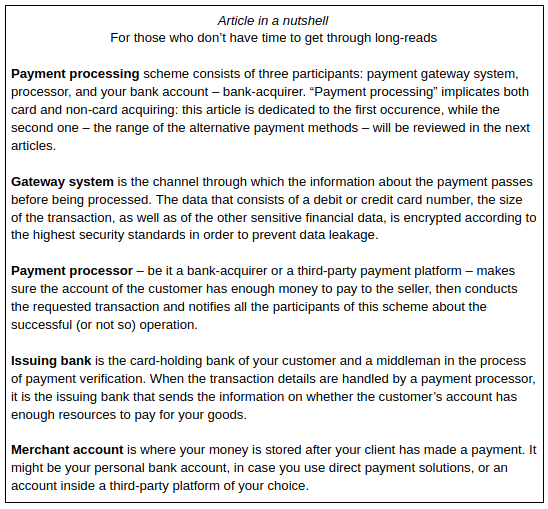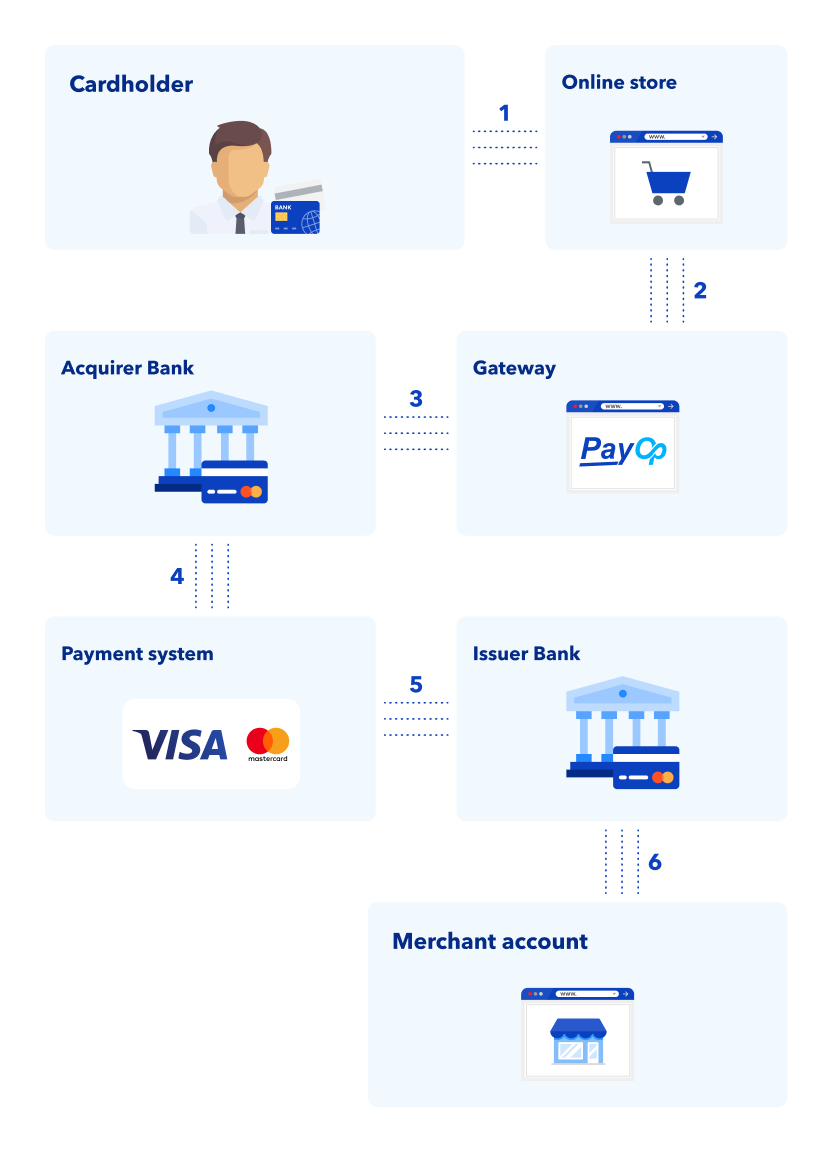What Is Payment Processing and How Does It Work?
Establishing an online business is as hard as organizing an actual shop. A merchant has to simultaneously take care of marketing, design, promotion, logistics, as well as of Search Engine Optimization – and, on top of that, pick up the most convenient payment methods for their website.
With each aspect demanding a huge amount of attention, it’s easy to lose sight of important details that will seriously influence your business. This is why, before approaching the question of payment methods, it would be great to determine what stands behind the invisible mechanisms that go on as you push the “Pay” button.
You may not be so interested in the financial nuances of the money transactions, yet, you have to understand what terms you agree when working with a payment system of your choice, as well as what fees you pay to each participant of the scheme. From the practical side, it is irrational to choose a platform for payment without knowing all the technical details about it.
In this article, we’re explaining what payment gateway systems are, what part do they take in money transactions, and where in this scheme belongs your merchant account.

What are the processes happening behind the purchase?
Your website is developed in order to sell your goods. Its design, smoothness, speed of load are optimized so that they’ll push a visitor to spend their money. And while this part of the UX relies on you, what happens after the “Buy” button is clicked is a sole responsibility of your chosen online payment system.
If you are oriented on a wide market, that is customers from European, American, African, Asian countries, then your marketplace has to offer convenient and known payment solutions to a wide variety of clients. Therefore, it is up to you to ascertain the functionality of the service you’ve chosen. Optimally, in a described case, you’d want to make sure that your payment channels aren’t limited by five options – according to the statistics, about 17% of UK customers prefer shopping on those sites that offer different payment methods. This data correlates with the polling, according to which customers would shop more on foreign websites if shops would offer local acquiring methods (59% Italian customers, 44% German customers, 55% Dutch customers, 47% French customers).
With payment processors like PayOp, that supports more than 300 acquiring methods, you make it possible for the clients from all around the world to choose convenient ways to pay for your goods.
The processing of your payments goes on thanks to a bunch of companies and financial entities that work with each other in order to make the purchase mechanism as smooth for merchants (and users) as possible. You don’t have to actually sign an agreement with your customer’s card-holding bank in order to receive paychecks from it – it is already done for you by the processor with which you can decide to cooperate.
Here’s what the process of buying goods from the Internet looks like from the technical point of view.

As the client chooses the preferable payment method and submits his financial information, the payment gateway is the channel through which all the delicate data is securely transmitted. The customer’s information might be encrypted via SSL or any other current protocols in order to protect it from leakage.
The online payment gateway safely delivers the request to the payment processor.

This is where the payment processor of your choice steps into a game. It contacts the Bank Card Association, which, in its turn, contacts the issuing bank of the submitted credit/debit card and receives the response whether the transaction can be conducted. The answer from the association comes back within bare seconds, depending on the Internet connection and the network’s load.

If the customer’s bank response was positive, then the payment processor simultaneously does two things:
- notifies the customer who purchased the goods about the successful acquiring of their payment
- sends money to the merchant’s balance, that is located inside the processor system

After all the actions take place, you receive the payment on your merchant account. There, all the paychecks from your customers are accumulated – it is your main account where all the financial operations can be monitored. But where does it exist, and how money can be derived from there?
What Is Merchant’s Account and Why Is It Needed
When dealing with customers from all over the world, you need to be ready to change payment methods depending on a customer’s local purchase options, as well as the issuing bank of his credit card. It is not possible to create your account in each and every bank in every country – yet, from the point of cost-effectiveness, it might be the most optimal solution.
This needs to be explained in detail. When facing a need to accept a transaction from a foreign country, you don’t have that many ways to proceed. Currently, the most popular payment solutions are SWIFT and SEPA, each of which has certain limitations that don’t allow the method to become widely used.
Looking at SEPA, it is a system that allows quickly (in 1 business day) and cheaply (from no to minimal fee) send money within the borders of EU and a couple of allied countries. The problem here is the narrowness of the system’s popularity – SEPA supports only 36 countries, which makes it impossible to work with American, African, Asian, and even some of the European countries.
SWIFT, on the other hand, is present in almost all countries around the world, which automatically makes it a mostly used option. Yet, the transaction fees there are almost unbearable and start from $20 – unreasonable price, which yet has to be paid if you need to send money in a currency different from Euro in a country outside of OECD (The Organisation for Economic Co-operation and Development, where SEPA works.)
As you can see, neither of the options allows a merchant to painlessly accept worldwide transactions, making it impossible to launch a successful business abroad.
Luckily, with the help of a single aggregator, these obstacles can be overstepped. Having a merchant account in a reliable payment system allows you to receive financial transactions from all over the world in local currencies. This way, you can have access to all your finances in a single place, from which they can be later sent to your personal accounts.
And, what is more, you don’t have to lose money on endless currency conversions! Speaking about which…
What Fees Do You Pay to Each Payment Processing Participant
Remember, what entities work together to send an online transaction from a buyer to a merchant? Well, all of them want to receive money for their services, which is why you usually pay four fees per each money transfer.

- The bank that has issued a customer’s credit card takes a certain percent for each fulfilling transaction – it is called interchange. The size of this fee is shifting; it depends on the specificity of the transaction (a type of purchase, amount of money, type of customer’s card, etc.)
- Credit card association that handles the request described in Step 2 takes card brand fees, or assessment, which is around $0.02.
- Another shifting fee that depends on the type of purchase, amount of money going through your account every month, and other characteristics, goes directly to your card-holder bank.
- The biggest percentage of each transaction is taken by your payment processor – and for a reason. It basically represents your business in the world of finances and takes care of every aspect of your income. Currency conversion? Secure money transactions? Payment processor participates in each of the operations, allowing you to forget about financial circumstances and concentrate on business growth.
The first three fees are struck off your account together, as a single rate. The processor’s fee depends on the service you’ve preferred and is evaluated individually for different payment methods the customers choose, countries of their inhabitancy, as well as the type of goods the merchant sells.
Why Using the Services of Payment Processor?
It may seem like the intervention of third parties inside the financial mechanisms only leads the rise of the acquiring cost – and it basically is, but not out of thin air.
Imagine facing a need to:
- sign deals and mediate the cooperation with 10, 20, 300 payment providers
- make sure that each of them works seamlessly
- react on all the occurred complications in-time
- solve all the disputes with the customers that didn’t receive the proper service/want to return your goods/wait for compensations, etc.
- keep track of all the operations in order to make proper financial accounting
And keep in mind that not all payment possibilities would be available to you as to an habitant of another country. How can you possibly offer a high level of service to your customers, or even manage all the other business-concerned tasks?
The availability of reliable payment processors made it possible for businessmen to create the franchise of their companies in other countries. PayOp, for example, highly supports small businesses and tries to offer the most loyal fees to them. With the help of our company, your business concerns wouldn’t include the constant monitoring and setting of payment methods.
Another indisputable advantage of an aggregating service is how all the transactions from your clients make their way to a single interface. This significantly changes the financial management for your company, allowing anyone with proper access to monitor your income. This way, you can use the already structured information in your needs, building graphs and raising statistics, seeing the progress of your company in time, its seasonal ups and downs, and, consequently, building optimized business strategy.
What happens after your customer decides to buy your goods is no secret, yet, it often stays out of the merchant’s attention. Dozens of big and small companies work together to make your life easier and let you receive the well-earned money without any delays.
Starting from the payment gateway and ending with a merchant’s account – the mechanism works like a Swiss watch. To receive payments from users, there’s no need to deep inside their mechanisms and learn all of them thoroughly, as there are user-friendly and intuitive services that provide you with such abilities and don’t additionally burden you with complex technical details.
Still, to understand how business works means to understand how you can upgrade it. From such point of view, this article is very useful for businessmen who aren’t satisfied with a superficial understanding of the “invisible” processes going under the shell of the payment processor.